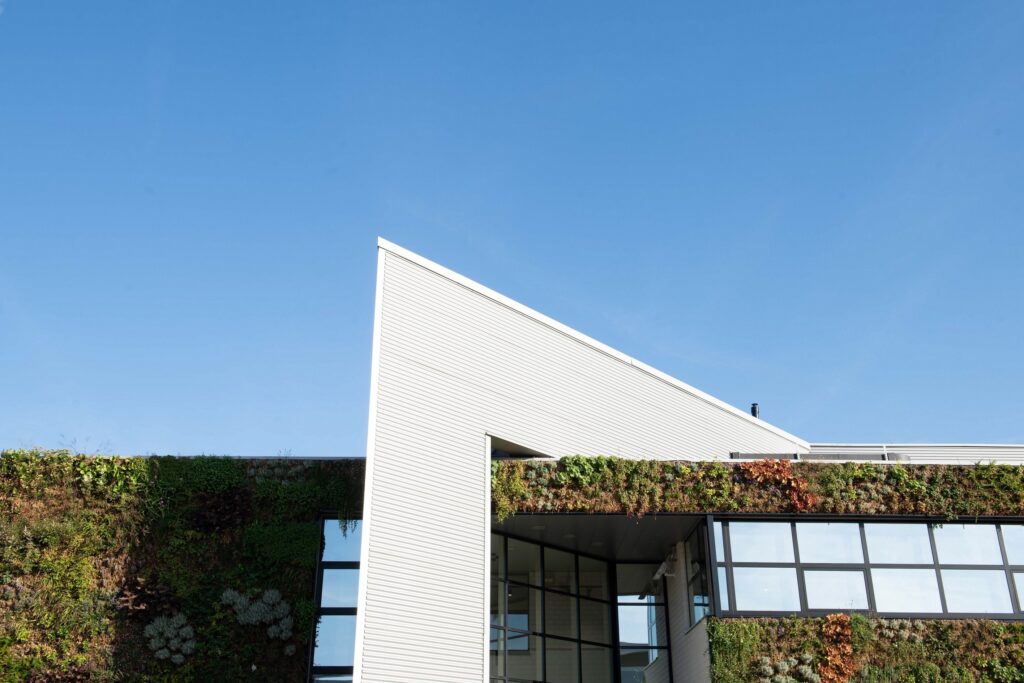Biomimicry in architecture: how designers look to nature
Sustainability in the built environment has never been a hotter topic. But did you know that architects are increasingly looking to the natural world for inspiration as they endeavour to design environmentally-friendly buildings?
It turns out the natural world had the answer to our eco dilemmas all along, and examples of architecture inspired by nature are now gracing cities around the world. The concept of replicating patterns and processes found in nature is known as biomimicry, and in this blog post we’re looking at some of the ways in which the natural world is influencing the design of sustainable buildings.

The Covent Garden building, Brussles, Belgium: first structure in Europe to have fully integrated natural purification and recycling systems.

BIOHM, a bio-based building materials company, took inspiration from nature to create an incredible solution for the construction industry to combat construction waste. Read more at Staiy.
“We may be architects or urban planners, but nature was an architect before us.” – Marc Somers, Managing Architect at Somersespace
What is biomimicry in design?
Biomimicry is the practice of learning from and mimicking the designs and processes originally found in nature. It draws from the patterns we find in the natural world as well as the biological blueprints that have proved to be incredibly successful over millions of years.
In relation to the built environment, biomimicry is in evidence in innovative architecture inspired by nature and in the use of sustainable, eco-friendly materials which help to protect the planet.
In the following sections, we look at some specific architecture biomimicry examples in order to gain a greater understanding of nature’s powerfully innovative influence.
EXAMPLE 1: AN INNOVATIVE OFFICE BUILDING USING PLANTS FOR PURIFICATION
European architecture studio ArtBuild drew on biomimicry for the design of an innovative office complex in Brussels’ city centre.
Featuring a large, central glass atrium populated with trees and plants, The Covent Garden building is the first structure in Europe to have fully integrated natural purification and recycling systems. Harnessing the power of phytosanitary plants, the water treatment system ensures the building is 95% self-sufficient in terms of water supply.
Related read: Eco-friendly architecture: the importance of sustainable design
EXAMPLE 2: A NEW INSULATION MATERIAL MADE FROM MUSHROOMS
Another good example of biomimicry used in design is a type of building insulation called BIOHM, from a UK based bio-manufacturing company. It's made from mycelium – the ‘root’ structure of mushrooms – along with a natural sheet material comprised of biowaste and a plant-based binder.
Bringing to the fore the concept of sustainability by design, Biohm was selected as a finalist for the 2021 Ray of Hope Prize which celebrates nature-inspired solutions to environmental challenges.
FibreGuard’s furnishing fabric collections can also contribute to effective insulation. Our multi-purpose furnishing fabrics help keep rooms warmer in winter and cooler in summer, enabling vital energy savings.
Looking at the design principles of sustainable design
As a fabric brand, we take our environmental impact to heart and are proactively working towards a lasting and meaningful positive impact on the planet with products certified under ISO 14001, GRS or OCS. What does this mean for you? It means that you can rest assured that your upholstered furniture will be safe for your family as well as for the environment!
FibreGuard's upholstery and drapery fabrics also have impressive eco credentials.
Our yarns require less water during washing because of their low absorption properties, and they also save energy during the drying process because of their higher than average dehydration speed. Also, as part of FibreGuard's certification under the the STANDARD 100 by OEKO-TEX®, all our fabrics are guaranteed entirely safe for skin contact.
Related read: What sustainable comfort means to us >
Watch how Biohm was inspired by fungi and nature's nutrient cycle to develop a building product that also reduces waste and sequesters CO2:
EXAMPLE 3: A BUILDING FAÇADE INSPIRED BY FLOWERS
An innovative building façade material called Pho’liage® is another great example of biomimicry in design and technology. Containing components capable of reacting to variations in the sun’s radiation, the material replicates the flower-like opening and closure mechanisms observed in the natural world.
The use of adaptive shading systems like this shows us how biomimicry advantages can help reduce our impact on the environment via increased energy efficiency.
Pho’liage® has been shown to reduce heating demands during winter as well as protecting the façade from overheating during the summer. Surplus solar energy is then converted into usable green electricity.
Related read: Sustainable design >

You have challenges. Nature has solutions. Learn more about Pho’liage® and innovation inspired by nature at Ask Nature.

Pho’liage: Towards a Kinetic Biomimetic Thermoregulating Façade: read more about this adaptive shading device
WHEN BUILDINGS DIE: A FINAL THOUGHT ON BIOMIMICRY
Another aspect of biomimicry relevant to the built environment is an awareness of the ‘life cycle’ of buildings. With longevity and sustainability in mind, contemporary buildings are now designed to last longer than their older counterparts. However, it still needs to be recognised that a building will, at some point, reach the end of its natural life.
“When we design a building, we now analyse the lifespan of its various components. Foreseeing the death of a building is also a form of biomimicry.” – Steven Ware, Partner Architect at ArtBuild Architects
Here at FibreGuard, we’re working to embed sustainability into everything we do to create both business value and sustainable impact, enabled by technology and human ingenuity.
Environmental sustainability in the textiles industry is a huge, layered topic, and there are no ‘magic bullet’ solutions to the climate change issues that are forecast to increase.
Read more about sustainability in the textiles industry and download our commitment to the future here.